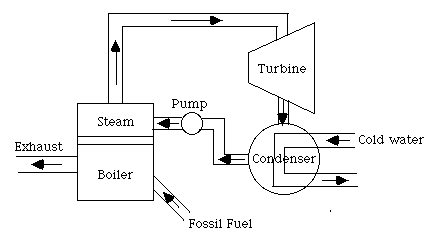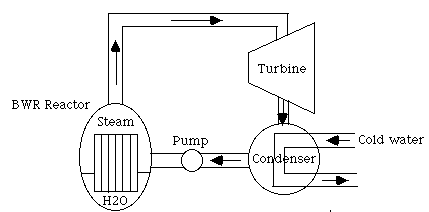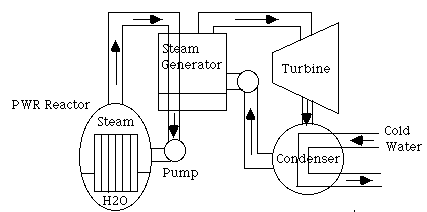The consequences of choosing a particular energy option include effects on:
 water
water land
land air
air plants
plants animals
animalsLecture X
The consequences of choosing a particular energy option include
effects on: water
water
 land
land
 air
air
 plants
plants
 animals
animals
The conventional sources used by utilities to produce electricity are:
 fossil-fuel combustion
fossil-fuel combustion nuclear energy
nuclear energy
Both use water to transfer energy between high and low temperature reservoirs and both methods generate waste heat.
How do these work and what are the common effects?
The fossil-fuel process is shown
below: This consists of a series of cycles:
 Fuel introduced (gas, fuel oil,
lump coal ...)
Fuel introduced (gas, fuel oil,
lump coal ...)
 Fuel is burned in
an open flame
Fuel is burned in
an open flame
 Spent fuel and
particles are exhausted
Spent fuel and
particles are exhausted
2:  Open flame heats water in HP
steam vessel
Open flame heats water in HP
steam vessel
 Steam is piped to
a turbine
Steam is piped to
a turbine  turbine rotates
turbine rotates
 Steam continues to
a condenser
Steam continues to
a condenser  water
water
 Water is pumped
to HP steam vessel
Water is pumped
to HP steam vessel
3:  Cold water from reservoir enters
condenser
Cold water from reservoir enters
condenser
 Heat is exchanged
from steam to cold water
Heat is exchanged
from steam to cold water
 Steam condenses to
water (
Steam condenses to
water ( T)
T)
 Water from
reservoir is heated (
Water from
reservoir is heated ( T')
T')
 Heated water goes
to reservoir and is cooled
Heated water goes
to reservoir and is cooled
4:  Turbine rotates and turns a coil in
B field
Turbine rotates and turns a coil in
B field
 AC is generated
(e.g. Chapter 4)
AC is generated
(e.g. Chapter 4)
The efficiency of conversion of
fossil-fuel to electricity is about 35%.
By using an Ammonia Water solution to:
- raise the dew point
The term reactor is used to denote a closed vessel in which nuclear processes produce thermal energy. There are several different types of nuclear reactor used in generating electricity. The most common types in the U.S. are the boiling water reactor (BWR) and the pressurized water reactor (PWR). A schematic representation of a BWR is shown below:

In the Boiling Water Reactor,
fuel elements are loaded in the reactor core surrounded by water.
As fission occurs, fragments are produced move through the fuel element
and water transferring energy to them.
This kinetic energy gets spread out in many collisions to become
thermal energy. The thermal energy boils the water to produce
steam (250°C) at about 70 times
atmospheric pressure (1000 lbs/in2). The steam drives
a turbine, etc. The maximum thermodynamic efficiency for this
process is about 45%, and 30%
is usually attained. In a Pressurized Water Reactor:
 raise the pressure to
2250 lbs/in2 (150 times atmospheric)
raise the pressure to
2250 lbs/in2 (150 times atmospheric)
 T=320°C
T=320°C
 add steam generator (higher T )
add steam generator (higher T )

The maximum thermodynamic efficiency ~50% with attained efficiencies of 30%.
The common factor in both fossil-fuel and nuclear energy generators
is the production of thermal energy. Thus, in accord with thermodynamics these processes must entail
thermal energy discharge at low temperature. So consider a 3000 MW plant with a 33% efficiency.
Of the 3000 MJ/sec, 1000 MJ/sec produce
electricity and 2000 MJ/sec
are exhausted into the environment as
waste heat. Waste heat effects:
 temperature of the water
temperature of the water
 dissolved oxygen in water
dissolved oxygen in water
Cold water contains more dissolved oxygen than warm water. Why?
Almost any pollutants in a river or lake need oxygen for their
neutralization:
 biological oxygen demand (organic)
biological oxygen demand (organic) chemical oxygen demand (inorganic)
chemical oxygen demand (inorganic)
 heat stresses the cleaning power
of water
heat stresses the cleaning power
of water
Heat also effects chemical
reactions. Rate of reaction roughly doubles for each 5-6°C temperature rise
(Arrhenius - e-E/kT). Finally, many species take on the temperature of their
environment (fish). Thus other effects as T rises include:
 algae grow faster
algae grow faster
 fish species replacement as T
changes
fish species replacement as T
changes
 reproduction decreases
reproduction decreases
 species immunity decreases -
disease
species immunity decreases -
disease
Rough  T of water are in
the 5-10°C range. This is a big change!
T of water are in
the 5-10°C range. This is a big change!
 need artificial cooling ponds
need artificial cooling ponds cooling towers
cooling towers
Before building a power plant an Environmental Impact Statement
must be prepared. This includes the following:
 economy of scale - many
facilities one site
economy of scale - many
facilities one site
 factory vs on-site fabrication
factory vs on-site fabrication
 new residents move into area
new residents move into area stress on infra-structure
stress on infra-structure stress on schools
stress on schools drop in productivity (turnover)
drop in productivity (turnover) rise in alcohol use
rise in alcohol use new taxes
new taxes
 smoke, fog
smoke, fog transmission lines
transmission lines pollution and emissions
pollution and emissions air quality
air quality noise
noise wildlife
wildlife scenic beauty
scenic beauty
 cost to build
cost to build cost to mine
cost to mine cost to produce
cost to produce amount produced
amount produced efficiency
(kWht - kWhe)
efficiency
(kWht - kWhe)
It typically takes 7 to 10 years of operation to reach the break
even point. Lessons that have taken a long time to learn: CARE and THOUGHT
CARE and THOUGHT pollution dilution solutions
don’t work!
pollution dilution solutions
don’t work!
 recovery is very long once natural
water filters are destroyed!
recovery is very long once natural
water filters are destroyed!
Problem of the day The claim is that a heat engine has
been developed that will operate by using the
temperature difference between the top and
bottom waters of a lake. It is solar powered since the Sun’s
energy sustains the temperature difference. Using a lake that is
104 m2 in area (i.e. 100m x 100m) and
in which the temperature of the top and bottom waters are 25°C
and 15°C respectively, the engine will run for centuries. It will
generate, on average, 1 MW of electricity. What do you think? Are the claims are consistent with 1st and 2nd laws of thermodynamics,
the conservation laws we love? 1st law states that energy is conserved:
Thus the maximum sustained electric power can not exceed what energy hits
the lake. P/A = 106W/104m2 = 100 W/m2 Since this is less than the solar flux
1372 W/m2, which rarely exceeds 500 W/m2, the 1st
law is satisfied. What about the 2nd law? What is the
2nd law? maximum efficiency = (TH-TL)/TH
So the maximum amount of power that could be generated is:
max power = 500 W/m2 x 104 m2 x 0.034
This is before losses!